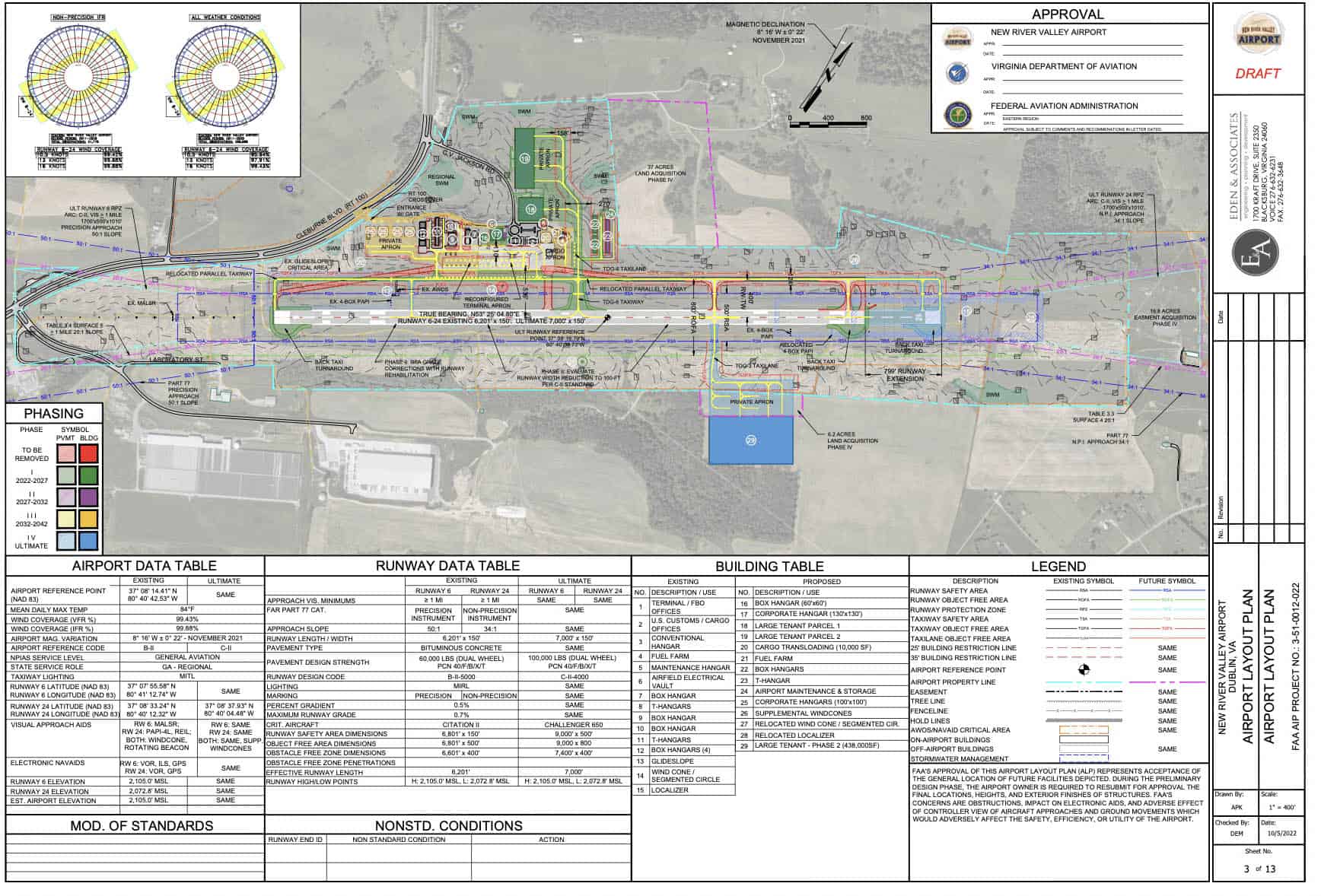NRV Airport Master Plan revealed
 By WILLIAM PAINE
By WILLIAM PAINE
The Patriot
This week, officials at the New River Valley Airport unveiled the Master Airport Plan, which specifies several improvements to the facility, which are set to occur over the next 20 years.
As can be seen in the accompanying diagram, improvements and new construction listed in the Airport Master Plan are divided into four separate stages, which are color coded. Green sections on the map are improvements that are expected to happen in the next five years, whereas areas marked in blue are considered long term goals. Items marked in gray are structure that currently exist at the NRV Airport.
Blacksburg based Eden and Associates is the engineering firm that produced the diagram and will oversee future construction.
According to Paul Brown of Eden and Associates, the first project to likely be completed is redirecting and then repaving the taxiway, which runs alongside the runway. The taxiway is a paved surface that provides airplanes access to and from the airport’s runway.
When the taxiway was constructed in the 1960’s, it met the standards of the time. These days, the Federal Aviation Administration (FAA) requires newly built taxiways to run parallel to the runway. The taxiway at the NRV airport runs at an angle before joining the runway, which according to the FAA, makes it less safe than it would be otherwise. The route of the newly planned taxiway is highlighted in yellow on the diagram.
Since it is seen as a safety concern, Airport Manager Aaron Brummitt believes the FAA will very likely approve the reworking of the taxiway in short order.
Another safety priority involves the removal of trees and power poles located Southwest of the airport, that could potentially be hazardous to airplanes as they approach the runway.
Money to complete safety-oriented improvements such as these typically comes from the Federal Government, which generally provides 90 percent of the funds, with 8 percent coming from the state and 2 percent provided by the airport. Grants are also available from the state, which generally provides 80 percent of the funds for a project, but require matching funds of 20 percent from the airport.
Other projects that are expected to be completed in the next five years include the construction of three new hangers on the airport grounds, which are marked in green by the numbers 16, 17 and 22.
“Some of the plan is based on past needs, some of it is based on what the needs will be in the next 20 years,” said Brummitt. “Hanger space is a perfect example for that. All of our hangars are completely full. “We’ve got a waiting list that is a mile long. It’s a regional issue in Southwest Virginia where all the airports are completely full and have hangar waiting lists.”
“A parallel taxiway is a safety related project, so that would be funded with Federal Money,” said Andrew Kratzer of Eden and Associates. “Other developments could be completely private. The state would pay for sitework for the hanger, but they wouldn’t pay for the building.”
The green blocks marked 18 and 19 are “tenant parcels” that could serve airport related private businesses or simply businesses that want to take advantage of close proximity to the airport.
“The larger buildings are for a larger aeronautical user, like a major repair or overhaul or a painting shop,” said Brummitt. “Something like that that would paint a larger sized aircraft like a Boeing 7 series. This airport is uniquely designed in that there is a lot of commercial property right next to the airport. Most airports in Virginia don’t have this much space. So, it’s very much geared towards large aeronautical usage.”
Retention ponds marked SWM on the diagram will have to be constructed to control the runoff from the impermeable surfaces created by these new buildings and their parking lots.
“These projects will likely occur in the next five years” said Brummitt. “Hangers will be based on demand but will most likely happen in five years, but if you don’t have these on the plan, then you can’t build it. If the FAA approves of the plan, you don’t have to jump through any hoops to get this done because it’s already been approved.”
There are no plans to resume passenger service, as when Piedmont flew regular flights into Pulaski County several years ago.
“If passenger service were to resume, we have a baggage check and an office available for the TSA, but there’s no huge demand now,” said Brummitt. “I think it’s a combination of the interstate highway system making car travel more efficient and the rising expense of air travel.”
Though the NRV Airport is unlikely to see passenger service anytime soon, shipments of freight are expected to continue and even grow well into the future.
“Volvo makes the majority of our freight,” said Brummitt. “We’ve actually got Volvo freight on the ramp right now. Parts that end up at Volvo probably make 60 to 70 percent of our commercial traffic. The rest of it would be commuter traffic, private charters, things of that nature.”
Other long-term goals for the NRV Airport include extending the 6,201 foot runway to 7,000 feet in length, as well as acquiring more land adjacent to the airport for future expansion.

